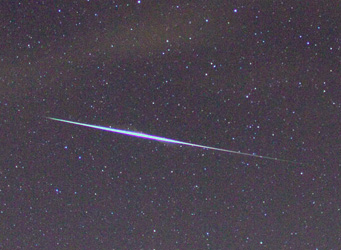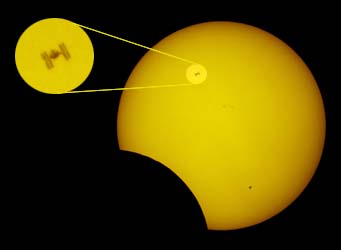My observing log from Monday night: Quadrantid meteors peak at 1h UT on 4 Jan, 8 p.m. tonight for me. Hoping to see some nice ones. Finally head outside with Cheryl around 11. Sky is crystal clear with no Moon, but temp is 15°F with strong wind. Bundled up so much I look like the Pillsbury dough-boy. We give up after 45 minutes of lying on frosty deck and staring straight up. Tally: Quadrantids, 0; nearly frozen fingers and toes, 40.
But as I would find out later, the Quadrantids did in fact put on a good show, peaking as predicted and delivering about 1 meteor per minute for an hour or two in dark skies over Europe.

It's the only Quadrantid meteor captured by Maryland skywatcher Mike Hankey during 10 hours of photography, but it's a doozy. Click here for a larger view.
Mike Hankey
One especially lucky skywatcher that night was Mike Hankey. Observing from his home in Freeland, Maryland, Hankey set up a fish-eye camera to take tracked 25-second exposures in the Moonless darkness from 8 p.m. to 6 a.m. "I only captured one meteor the whole night, but it was a good one," he notes.
At 2:43 a.m. Eastern time on January 4th, several hours after the meteors peaked, a small fireball that flashed through the camera's field and left a glowing train that lingered in 20 consecutive frames (almost 10 minutes). Check out his awesome animation of those images here.
My observing-log entry has a postscript: My string of bad luck while skywatching continues. Clouded out for December total lunar eclipse; saw nothing from the Quads; and I'm going to miss tomorrow's partial solar eclipse too.
As I noted earlier this week, observers in Europe, northern Africa, and western Asia were treated to a deep partial eclipse of the Sun on Tuesday morning — in addition to seeing the Quadrantid peak. (Note to self: Buy summer home in French Pyrenees.)
Reports we've received suggest that most Europeans struggled with clouds during the eclipse, some only getting a brief glimpse at sunrise or through momentary breaks.

A transit of the International Space Station (shown enlarged in inset) during the partial solar eclipse on January 4, 2011. Click here to see a larger view.
Thierry Legault
But veteran astrophotographer Thierry Legault had a plan, and he executed it perfectly. Legault traveled to Oman. "It's a very nice country to visit," he notes, "with the sea, mountains, nice villages, etc."
But Legault hadn't gone to Oman for the scenery. He'd used the CalSky website to figure out where on Earth he'd be able to watch the International Space Station transit the Sun during the eclipse. The choice was easy: the area near Muscat in Oman turned out to be the only possible location.
He recorded the image here at 9:09 Universal Time with a Takahashi FSQ-106ED refractor and a Canon 5D camera. Orbiting at 17,000 miles (28,000 km) per hour, the ISS crossed the Sun fast — in just 0.9 second from his location — so he triggered 1⁄5000-second frames as fast as possible (four per second). The result of all that effort, as you can see, is awesome. You'll find more details here.
Many others skywatchers have contributed their eclipse pictures to our online gallery. And be sure to check out the views here and the great video here from Japan's Hinode space observatory, which saw the eclipse as annular from its vantage 420 miles (680 km) above Earth's north-polar region.
Note to self: For next year's annular solar eclipse, leave nothing to chance. Hit up friends for cash, then charter a jet.
 2
2









Comments
David A. Rodger
January 7, 2011 at 8:46 am
When I first saw this extraordinary photo I thought I was looking at the Canadian flag on the sun's surface. The ISS, from that perspective, looks remarkably like our flag.
You must be logged in to post a comment.
marcus
February 12, 2011 at 1:30 pm
WOW
You must be logged in to post a comment.
You must be logged in to post a comment.